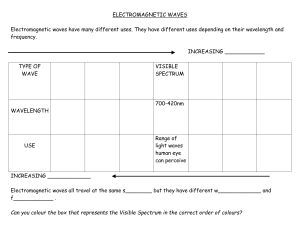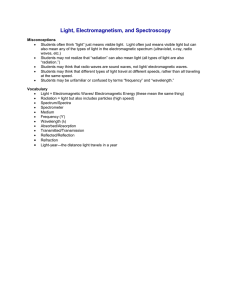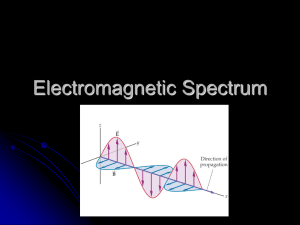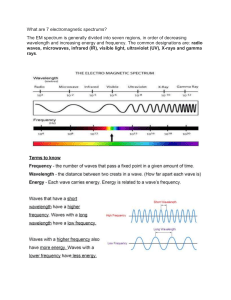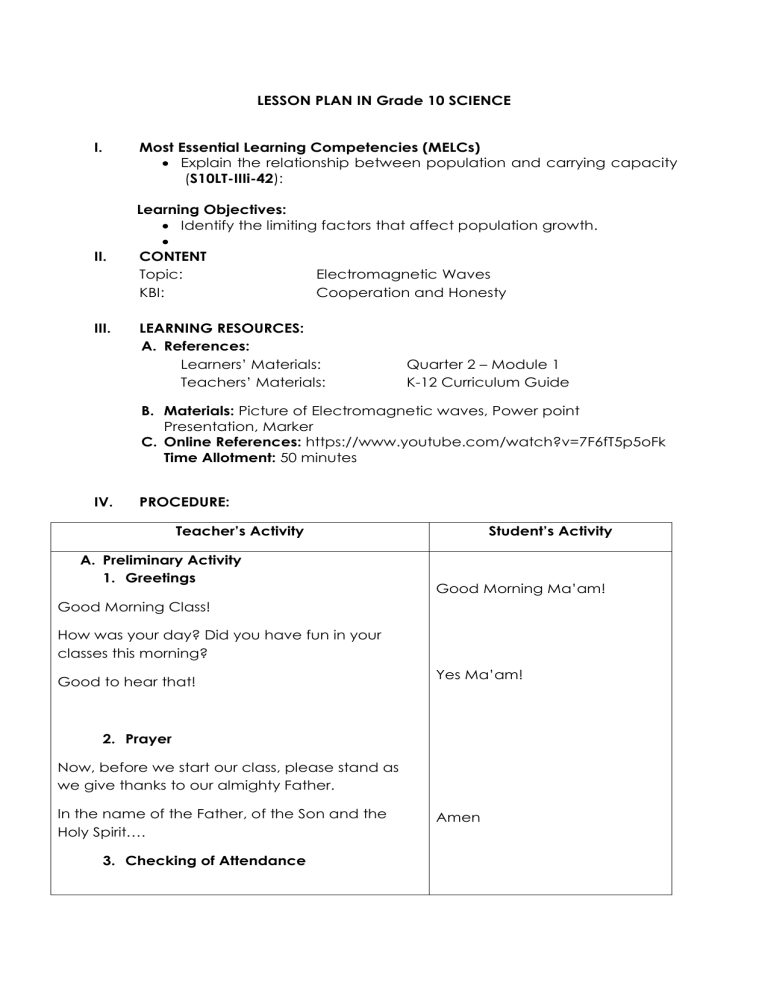
LESSON PLAN IN Grade 10 SCIENCE I. Most Essential Learning Competencies (MELCs) Explain the relationship between population and carrying capacity (S10LT-IIIi-42): II. III. Learning Objectives: Identify the limiting factors that affect population growth. CONTENT Topic: Electromagnetic Waves KBI: Cooperation and Honesty LEARNING RESOURCES: A. References: Learners’ Materials: Teachers’ Materials: Quarter 2 – Module 1 K-12 Curriculum Guide B. Materials: Picture of Electromagnetic waves, Power point Presentation, Marker C. Online References: https://www.youtube.com/watch?v=7F6fT5p5oFk Time Allotment: 50 minutes IV. PROCEDURE: Teacher’s Activity A. Preliminary Activity 1. Greetings Student’s Activity Good Morning Ma’am! Good Morning Class! How was your day? Did you have fun in your classes this morning? Good to hear that! Yes Ma’am! 2. Prayer Now, before we start our class, please stand as we give thanks to our almighty Father. In the name of the Father, of the Son and the Holy Spirit…. 3. Checking of Attendance Amen Alright! Please take your seats. I’ll be checking your attendance. May I know the absentee? Perfect! Since nobody is absent today let us give ourselves Five claps. None ma’am! 4. Checking of Assignment Now kindly submit your assignment on the center, and then the center kindly pass it to the front. B. Developmental Activity a. Drill Before we proceed with our lesson for today, I have prepared a game! I have here a jumbled words and let’s see how you are going unlock the hidden word. RRIDNAFE DWEAVARIO TULVOIARTEL EMROWVACI MAMGA YAR BILEIVS GTHIL XYAR INFRARED RADIOWAVE ULTAVIOLET MICROWAVE GAMMA RAY VISIBLE LIGHT XRAY Alright! You got all the words correctly. What do you think these words are? b. Elicit Our lesson yesterday was about the Nature of Electromagnetic Wave. What are the properties of EM Waves? We have Three Properties. What are those? Perfect! For our next activity, I will give a statement and then you have to identify if it is TRUE or FALSE. Are you ready? 1. Most EM waves have the same speed. 2. EM waves travel at the speed of 4x108 m/s. 3. Electromagnetic waves are transverse waves consisting of changing electric fields and changing magnetic fields. Ma’am our lesson yesterday is about the Nature of Electromagnetic Wave. 1. They are produced by accelerated or oscillating charge. 2. They do not require any material or medium for propagation. 3. They travel in free space at the speed of 3x108 m/s. Yes Ma’am! 4. Electromagnetic waves transfer energy through a vacuum. 5. A wave is a disturbance that transfers energy. 1. 2. 3. 4. 5. FALSE FALSE TRUE TRUE TRUE c. ENGAGE This time, I will be showing to you a short video clip about electromagnetic spectrum and I have here the guided questions that you will answer after watching the video. 1. What makes up electromagnetic waves? 2. What colors makes up the visible light? 3. Which of the electromagnetic waves has the highest frequency? 4. Which of the electromagnetic waves has the lowest frequency? 5. Which of the electromagnetic waves has the longest wavelength? 6. Which of the electromagnetic waves has the shortest wavelength? Excellent! All of your answers are correct. 1. Oscillating Magnetic Field and Electric Field. 2. RED, ORANGE, YELLOW, GREEN, BLUE, INDIGO, and VIOLET. 3. Gamma Ray has the highest frequency Ma’am. 4. Radio wave has the lowest frequency Ma’am. 5. Radio wave has the longest wavelength Ma’am. 6. Gamma Ray has the shortest wavelength Ma’am. d. EXPLORE Now, we will do another activity. I will group you into three (3) and Group 1 will be TEAM STAR RADIO, Group 2 will be TEAM AKSYON RADIO, and lastly Group 3 will be TEAM MOR. Each group will assign a team leader, secretary, time keeper and a presenter. Now, before we start our activity let us be reminded again with our guidelines in performing an activity. TEAM STAR RADIO 1. Respect each other opinion 2. Be cooperative 3. Finish the activity on time 4. Read the instructions carefully before doing the activity Instructions: Compare the relative wavelengths and frequency of different forms of electromagnetic waves by using the picture of EM Waves. Team Star Radio will determine the relative wavelength and frequency of EM waves by studying the picture and they will compare the relative wavelength and frequency of EM waves using the table. Electromagnetic Waves’ Wavelength and Frequency EM Wave Frequency Range (hertz) Wavelength Range (meters) Radio wave Microwave Infrared Visible Light Ultraviolet X-rays Gamma rays TEAM AKSYON RADIO Instructions: Arrange the EM spectrum in decreasing wavelength and increasing frequency. Number each EM wave from 1-7. Number 1 is the longest wavelength and the lowest frequency. ___________ visible light ___________ infrared ___________ X ray ___________ radio wave ___________ gamma ray ___________ ultraviolet ___________ microwave Team Aksyon Radio student will go in front and they will arrange the given EM waves in decreasing wavelength and increasing frequency. TEAM MOR Instructions: Complete the Electromagnetic Spectrum Chart by arranging the different types of EM waves. Team MOR will complete the EM Chart by arranging the different types of EM Waves. e. EXPLAIN Based from your activity, let us see if you we can answer the following questions. 1. What are the limiting factors that affect population growth? 2. How does population growth affect the carrying capacity of an ecosystem? 1. What is the relationship of frequency and wavelength in the electromagnetic spectrum? 2. What is the relationship of frequency and energy in the electromagnetic spectrum? 1. From radio waves to gamma ray the wavelength is decreasing. The radio waves has the longest wavelength and the gamma ray has the shortest wavelength. Also, for their frequency from radio waves to gamma ray is increasing. The radio wave has the lowest frequency and gamma ray has the highest frequency. 2. The frequency and wavelength in the electromagnetic spectrum is inversely proportional. As one goes up, the other goes down. 3. The frequency and energy in the electromagnetic spectrum is directly proportional. As on goes up, the other goes up as well. f. ELABORATE Based from your activity, you have learned that electromagnetic is arranged according to its wavelength and frequency in what is known as Electromagnetic Spectrum. 1. What happens to the wavelength of an electromagnetic wave if its frequency increases? Excellent! As frequency increases on the EM Spectrum, the wavelength decreases. In other words, wavelength and frequency are inversely proportional to each other. So, that means radio waves have the longest wavelengths and gamma rays have the shortest. 2. How is an electromagnetic spectrum organized in terms of its frequency and wavelength? 3. How do electromagnetic waves play an important role in your life? 4. Which Subject Areas, do you think you can apply your knowledge about EM Waves? 1. If the frequency of EM Waves increases the wavelength decreases. 2. The EM Spectrum is organized according to increasing frequency and decreasing wavelength. 3. Electromagnetic waves plays an important role in our daily life. These waves have many uses which are vital to our daily lives: visible light allows us to see; microwaves and radio waves allow for long-rang communications via mobile phones, televisions and radio, x-rays are used in medical imaging and many more. 4. Student answers may vary g. EVALUATE I. FILL IN THE BLANK Directions: Compare the following EM waves and fill in the missing word to complete the statement. Use the descriptions such as lower, higher, shorter and longer. Write your answer on a ½ sheet of paper. 1. 2. 3. 4. 5. II. Radio wave is ____________ in wavelength than the gamma ray. Microwave is ___________ in frequency than infrared. Infrared is __________ in wavelength than visible light. X-ray is ___________ in wavelength than gamma ray. Gamma ray is ____________ in frequency than microwave. MATCHING TYPE Directions: Match column A with the correct answer on column B, write only the letter of answer on the blank provided before the number. 6. 7. 8. 9. 10. What is the relationship of wavelength and frequency in the different forms of EM waves? What happens to the frequency of the electromagnetic waves if its wavelength increases? Which of the following forms of electromagnetic waves has the widest frequency range? How the wavelength of infrared differs from the wavelength of ultraviolet waves? Which EM waves has the highest frequency than others? A. Gamma Ray B. Decreases C. Increases D. Inversely Proportional E. Longer F. Shorter G. Directly Proportional h. EXTEND Cite at least five (5) practical application of different forms of electromagnetic waves. V. VI. REMARKS REFLECTION
